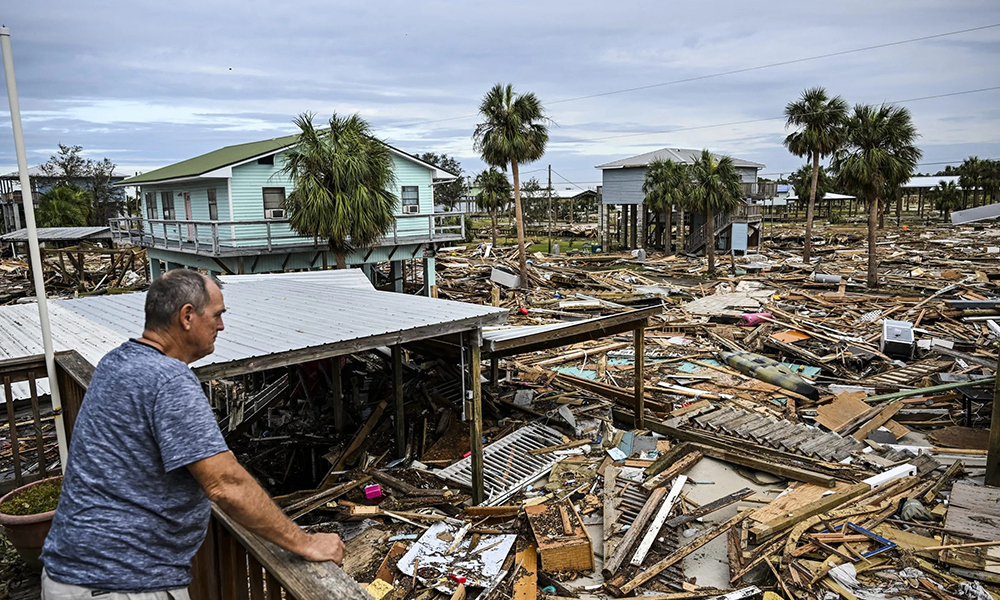
飓风米尔顿正在逼近佛罗里达州,对于尚未从飓风海伦妮造成的损失中恢复过来的成百上千万当地居民和保险公司而言,这场4级飓风可能造成灾难性的影响。
富国银行(Wells Fargo)在一份研究报告中表示:“飓风米尔顿将造成超过百亿美元保险损失。”这份报告预估的损失将达到100亿至1,000亿美元。但按照基准情景预估,损失规模为200亿美元。富国银行表示,无论如何,市场价格似乎将500亿美元损失考虑在内。
但这对于保险公司和再保险公司意味着什么?对于它们的盈利会有哪些影响?在损失超过500亿美元的情景下,按照富国银行的保险范围计算,这相当于3.5%的股权和106%的第四季度收益,或者全年收益的20%。富国银行的报告显示,基准情景显然更加乐观,损失金额相当于约1.5%的股权和43%的第四季度收益,或全年收益的8%。而且,富国银行表示,飓风米尔顿和海伦妮结束后,再保险费率将提高,这可能意味着业主需要支付更高保费。
据CoreLogic估算,9月末形成的飓风海伦妮以4级飓风的形式席卷了佛罗里达州的部分地区,造成的有保险和无保险洪水与风灾损失总额为305亿至475亿美元。此外,穆迪(Moody’s)估计飓风海伦妮在美国私人市场造成的保险损失为80亿至140亿美元,最可靠的估计为110亿美元。去年,美国共发生了28次天气和气候灾难,共造成了约930亿美元损失。
今年的飓风季还将持续两个月时间,已经有多个飓风登陆美国。自上世纪80年代以来,美国每年平均发生约8次严重天气事件,造成的损失至少高达10亿美元。过去5年,造成至少10亿美元损失的严重天气事件的平均次数不断攀升,截至去年10月已达到18次。CoreLogic的首席创新官约翰·罗杰斯当时曾告诉我,情况只会越来越糟。罗杰斯说道:“可惜,严重天气事件可能变得更严重,发生频率更高。”
所以我们才会看到保险商纷纷逃离佛罗里达州。对于保险公司而言,佛罗里达州是一个极具挑战性的市场;它们无法管理风险敞口;它们早已表明了态度。而佛罗里达州以及其他地区的业主和小房东,要么找不到保险,要么负担不起保险,而且即使他们可以投保,也要支付更高的保费。在全美范围内,单户住宅的平均财产保险保费比四年前上涨了52%;根据所在地不同,实际支付金额可能更高。
这导致不可保险财产增多。今年发布的一份报告发现,三年前,无保险房屋约1.6万亿美元的财产价值面临风险,有610万业主没有购买保险。随着保险问题变得更加突出,情况可能已经恶化。想想看,你现在可以在Zillow上查找房屋,它会向你展示房屋存在的气候风险。(财富中文网)
译者:刘进龙
审校:汪皓
飓风米尔顿正在逼近佛罗里达州,对于尚未从飓风海伦妮造成的损失中恢复过来的成百上千万当地居民和保险公司而言,这场4级飓风可能造成灾难性的影响。
富国银行(Wells Fargo)在一份研究报告中表示:“飓风米尔顿将造成超过百亿美元保险损失。”这份报告预估的损失将达到100亿至1,000亿美元。但按照基准情景预估,损失规模为200亿美元。富国银行表示,无论如何,市场价格似乎将500亿美元损失考虑在内。
但这对于保险公司和再保险公司意味着什么?对于它们的盈利会有哪些影响?在损失超过500亿美元的情景下,按照富国银行的保险范围计算,这相当于3.5%的股权和106%的第四季度收益,或者全年收益的20%。富国银行的报告显示,基准情景显然更加乐观,损失金额相当于约1.5%的股权和43%的第四季度收益,或全年收益的8%。而且,富国银行表示,飓风米尔顿和海伦妮结束后,再保险费率将提高,这可能意味着业主需要支付更高保费。
据CoreLogic估算,9月末形成的飓风海伦妮以4级飓风的形式席卷了佛罗里达州的部分地区,造成的有保险和无保险洪水与风灾损失总额为305亿至475亿美元。此外,穆迪(Moody’s)估计飓风海伦妮在美国私人市场造成的保险损失为80亿至140亿美元,最可靠的估计为110亿美元。去年,美国共发生了28次天气和气候灾难,共造成了约930亿美元损失。
今年的飓风季还将持续两个月时间,已经有多个飓风登陆美国。自上世纪80年代以来,美国每年平均发生约8次严重天气事件,造成的损失至少高达10亿美元。过去5年,造成至少10亿美元损失的严重天气事件的平均次数不断攀升,截至去年10月已达到18次。CoreLogic的首席创新官约翰·罗杰斯当时曾告诉我,情况只会越来越糟。罗杰斯说道:“可惜,严重天气事件可能变得更严重,发生频率更高。”
所以我们才会看到保险商纷纷逃离佛罗里达州。对于保险公司而言,佛罗里达州是一个极具挑战性的市场;它们无法管理风险敞口;它们早已表明了态度。而佛罗里达州以及其他地区的业主和小房东,要么找不到保险,要么负担不起保险,而且即使他们可以投保,也要支付更高的保费。在全美范围内,单户住宅的平均财产保险保费比四年前上涨了52%;根据所在地不同,实际支付金额可能更高。
这导致不可保险财产增多。今年发布的一份报告发现,三年前,无保险房屋约1.6万亿美元的财产价值面临风险,有610万业主没有购买保险。随着保险问题变得更加突出,情况可能已经恶化。想想看,你现在可以在Zillow上查找房屋,它会向你展示房屋存在的气候风险。(财富中文网)
译者:刘进龙
审校:汪皓
Hurricane Milton is barreling toward Florida, and the category 4 storm could be catastrophic for millions of people and insurers who are still recovering from Hurricane Helene.
“Milton should be a double-digit billion insured loss,” Wells Fargo said in a research note, estimating those losses could be anywhere between $10 billion and $100 billion. Its base case, however, is $20 billion worth of losses. Either way, the market seems to be pricing in more than $50 billion in losses, the bank said.
But what does that mean for insurers and reinsurers and their bottom line? In a more than $50 billion loss scenario, in terms of Wells Fargo’s coverage, it could equate to 3.5% of equity and 106% of fourth-quarter earnings, or 20% of earnings for the entire year. Obviously the bank’s base-case scenario would be better, amounting to roughly 1.5% of equity and 43% of fourth-quarter earnings, or 8% of full-year earnings, per the note. Not to mention, reinsurance rates could rise on the back of Hurricane Milton and Hurricane Helene, Wells Fargo said, which would essentially mean higher premiums for homeowners.
Hurricane Helene, which formed in the late days of September and hit parts of Florida as a category 4 storm, resulted in between $30.5 billion and $47.5 billion of total insured and uninsured, flood and wind losses, according to CoreLogic. Additionally, Moody’s estimates total U.S. private market insured losses from Hurricane Helene to be between $8 billion and $14 billion, with a best estimate of $11 billion. Last year there were 28 weather and climate disasters, amounting to about $93 billion in damages.
There are about two more months of hurricane season, and multiple hurricanes have already made landfall. Since the 1980s, the country has averaged around eight major weather events per year that caused at least $1 billion in damage. In the past five years the average number of major weather events causing at least a billion dollars in damage has climbed, reaching 18 as of last October. At the time, John Rogers, chief innovation officer at CoreLogic, told me it was only going to get worse. “The severity and frequency of major weather events, unfortunately, is likely to go up,” Rogers said.
It’s why we’re seeing insurers fleeing Florida. The market is too challenging for them; they can’t manage the risk exposure; they’ve said it all. And homeowners and small landlords in Florida and beyond, well, they either can’t find or afford coverage, and if they can, they’re dealing with much higher premiums. Across the country, the average property insurance payment for single-family homes is 52% higher than it was four years ago; the actual payment can be higher depending on where you live.
It’s given rise to uninsurable properties. An estimated $1.6 trillion in property value of uninsured homes was at risk three years ago and 6.1 million homeowners were uninsured, a report published this year found. The situation has likely worsened as insurance woes are becoming more prominent. Just think, you can now look up homes in Zillow, and it will present you with climate risks.






